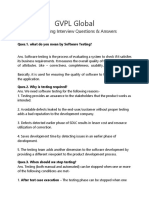0 ratings0% found this document useful (0 votes)
21 viewsIntroduction To Parallel Architectures - Josep Torrellas - CS533 (2012)
Uploaded by
alastoridCopyright
© © All Rights Reserved
Available Formats
Download as PDF, TXT or read online on Scribd
0 ratings0% found this document useful (0 votes)
21 viewsIntroduction To Parallel Architectures - Josep Torrellas - CS533 (2012)
Uploaded by
alastoridCopyright
© © All Rights Reserved
Available Formats
Download as PDF, TXT or read online on Scribd
You are on page 1/ 14
Introduction to Parallel Architectures
Instructor: Josep Torrellas
CS533
Copyright Josep Torrellas 2012 1
Introduction
• Why parallel architectures:
– Absolute performance
– Power and energy
– Complexity
– Cost-performance
• Key enabling factors:
– Advances in semiconductor and interconnect technology
– Advances in software technology
Copyright Josep Torrellas 2012 2
Classification of Parallel Machines
• Michael Flynn’s classification
• Model-based classification
Copyright Josep Torrellas 2012 3
Flynn’s Classification
• Based on the notions of:
– Instruction streams and data streams
• The parallel organizations are characterized by the multiplicity of
hardware provided to service I and D streams:
– SISD: Single Instruction and Single Data Stream (uniprocessor)
– SIMD: Single I and Multiple D Streams (GPUs)
– MISD: Multiple I and Single D Streams
– MIMD: Multiple I and Multiple D Streams (multicores)
Copyright Josep Torrellas 2012 4
Model-Based Classification
• Shared-memory
• Message-passing
• Dataflow
• Systolic
• Data parallel
Copyright Josep Torrellas 2012 5
Shared-Memory Architectures
• Key feature: all processors in the system can directly access all
memory locations in the system, thus providing a convenient
and cheap mechanism for multiple processors to share data
– Convenient: (i) location transparency, (ii) abstraction
supported is same as that of uniprocessors
– Cheap: as compared to other models (more later)
• Memory can be centrally placed or distributed
• Better name is Single address space machines
Copyright Josep Torrellas 2012 6
• Programming model:
– Variety of parallel models can be easily supported: fork-join
model, task queue model, data parallel model.
– Parallel threads use shared-memory for communication and
synchronization
• A problem traditionally cited with such machines is scalability
• However, the programming model is very general and can easily
emulate the other models
Copyright Josep Torrellas 2012 7
Message Passing Architectures
• Processors can directly access only local memory, and all
comm. and synch happens via messages
• Sending a message often incurs many overheads:
– Building a header, copying data into network buffers,
sending data, receiving data into buffers, copying data from
kernel to user process address space
– Many of these steps may require OS intervention
• Synchronization using messages is typically based on various
handshake protocols
• One of the main advantages is easy scalability
Copyright Josep Torrellas 2012 8
Message Passing Architectures
• A variety of programming models can be supported:
– Actor model, Concurrent-object oriented programming
• Very popular:
– Clusters
– Cloud computing
– Supercomputing
Copyright Josep Torrellas 2012 9
Dataflow
• In the dataflow model, instructions are activated by the availability
of data operands for instructions
A = (B+1)* (B-C)
D=C*E
F=A*D
• In control flow models, computation is a series of instructions with
implicit or explicit sequencing between them
• One of the advantages is that all dependences are explicitly present
in the dataflow graph, so parallelism is not hidden from hardware
Copyright Josep Torrellas 2012 10
Dataflow
• Many variations exist
• Some issues:
– Granularity of operations (locality issues)
– Efficient handling of complex data structures like arrays
– Complexity of the matching store
– Problems due to excess of parallelism
Copyright Josep Torrellas 2012 11
Systolic Architectures
• Basic principle:
– Replace a single PE by a regular array of PEs and carefully
orchestrate the flow of data between Pes
– Result: high throughput without increasing memory
bandwidth requirements
• Distinguishing features from regular pipelined computers:
– Array structure can be non-linear (e.g. hexagonal)
– Pathways between the PEs may be multidirectional
– PEs may have local instruction and data memory, and are
more complex than the stage of a pipelined computer
Copyright Josep Torrellas 2012 12
Systolic Architectures
• Issues:
– System integration: Shipping data from host array and back
– Cell architecture and communication architecture
– Software for automatically mapping computations to systolic arrays
– General purpose systolic arrays
• Popular in signal processing
Copyright Josep Torrellas 2012 13
Data Parallel Architectures
• Programming model assumes that there is a processor associated with
each member of a collection of data
• All processors execute similar operations on different data, not in
lockstep
• Useful for highly parallel codes
• Used by graphics processors
Copyright Josep Torrellas 2012 14
You might also like
- The Subtle Art of Not Giving a F*ck: A Counterintuitive Approach to Living a Good LifeFrom EverandThe Subtle Art of Not Giving a F*ck: A Counterintuitive Approach to Living a Good Life4/5 (6124)
- The Gifts of Imperfection: Let Go of Who You Think You're Supposed to Be and Embrace Who You AreFrom EverandThe Gifts of Imperfection: Let Go of Who You Think You're Supposed to Be and Embrace Who You Are4/5 (1148)
- Never Split the Difference: Negotiating As If Your Life Depended On ItFrom EverandNever Split the Difference: Negotiating As If Your Life Depended On It4.5/5 (933)
- Hidden Figures: The American Dream and the Untold Story of the Black Women Mathematicians Who Helped Win the Space RaceFrom EverandHidden Figures: The American Dream and the Untold Story of the Black Women Mathematicians Who Helped Win the Space Race4/5 (954)
- The Hard Thing About Hard Things: Building a Business When There Are No Easy AnswersFrom EverandThe Hard Thing About Hard Things: Building a Business When There Are No Easy Answers4.5/5 (361)
- The World Is Flat 3.0: A Brief History of the Twenty-first CenturyFrom EverandThe World Is Flat 3.0: A Brief History of the Twenty-first Century3.5/5 (2283)
- Devil in the Grove: Thurgood Marshall, the Groveland Boys, and the Dawn of a New AmericaFrom EverandDevil in the Grove: Thurgood Marshall, the Groveland Boys, and the Dawn of a New America4.5/5 (278)
- A Heartbreaking Work Of Staggering Genius: A Memoir Based on a True StoryFrom EverandA Heartbreaking Work Of Staggering Genius: A Memoir Based on a True Story3.5/5 (692)
- CINEO C2040: Monofunctional Automated Teller Machine For Indoor Installations50% (2)CINEO C2040: Monofunctional Automated Teller Machine For Indoor Installations2 pages
- Game Design With Unity Engine and InstallationNo ratings yetGame Design With Unity Engine and Installation10 pages
- Assignment Brief Unit 20 Advanced Programming Sep 2022No ratings yetAssignment Brief Unit 20 Advanced Programming Sep 20222 pages
- Introduction To Computing Applied Business Tools and TechnologiesNo ratings yetIntroduction To Computing Applied Business Tools and Technologies9 pages
- (PDF Download) Practical Vaadin: Developing Web Applications in Java 1st Edition Alejandro Duarte Fulll Chapter100% (3)(PDF Download) Practical Vaadin: Developing Web Applications in Java 1st Edition Alejandro Duarte Fulll Chapter64 pages
- 112 Manual Testing Interview Questions & AnswersNo ratings yet112 Manual Testing Interview Questions & Answers26 pages
- Digi Device Customization and Integration GuideNo ratings yetDigi Device Customization and Integration Guide69 pages
- Spectrum Media and Wrapper Formats RevGNo ratings yetSpectrum Media and Wrapper Formats RevG18 pages
- Arduino Introduction and Advanced ResourNo ratings yetArduino Introduction and Advanced Resour94 pages
- The Subtle Art of Not Giving a F*ck: A Counterintuitive Approach to Living a Good LifeFrom EverandThe Subtle Art of Not Giving a F*ck: A Counterintuitive Approach to Living a Good Life
- The Gifts of Imperfection: Let Go of Who You Think You're Supposed to Be and Embrace Who You AreFrom EverandThe Gifts of Imperfection: Let Go of Who You Think You're Supposed to Be and Embrace Who You Are
- Never Split the Difference: Negotiating As If Your Life Depended On ItFrom EverandNever Split the Difference: Negotiating As If Your Life Depended On It
- Hidden Figures: The American Dream and the Untold Story of the Black Women Mathematicians Who Helped Win the Space RaceFrom EverandHidden Figures: The American Dream and the Untold Story of the Black Women Mathematicians Who Helped Win the Space Race
- The Hard Thing About Hard Things: Building a Business When There Are No Easy AnswersFrom EverandThe Hard Thing About Hard Things: Building a Business When There Are No Easy Answers
- Elon Musk: Tesla, SpaceX, and the Quest for a Fantastic FutureFrom EverandElon Musk: Tesla, SpaceX, and the Quest for a Fantastic Future
- The Emperor of All Maladies: A Biography of CancerFrom EverandThe Emperor of All Maladies: A Biography of Cancer
- The Little Book of Hygge: Danish Secrets to Happy LivingFrom EverandThe Little Book of Hygge: Danish Secrets to Happy Living
- The Yellow House: A Memoir (2019 National Book Award Winner)From EverandThe Yellow House: A Memoir (2019 National Book Award Winner)
- The World Is Flat 3.0: A Brief History of the Twenty-first CenturyFrom EverandThe World Is Flat 3.0: A Brief History of the Twenty-first Century
- Devil in the Grove: Thurgood Marshall, the Groveland Boys, and the Dawn of a New AmericaFrom EverandDevil in the Grove: Thurgood Marshall, the Groveland Boys, and the Dawn of a New America
- The Sympathizer: A Novel (Pulitzer Prize for Fiction)From EverandThe Sympathizer: A Novel (Pulitzer Prize for Fiction)
- A Heartbreaking Work Of Staggering Genius: A Memoir Based on a True StoryFrom EverandA Heartbreaking Work Of Staggering Genius: A Memoir Based on a True Story
- Team of Rivals: The Political Genius of Abraham LincolnFrom EverandTeam of Rivals: The Political Genius of Abraham Lincoln
- On Fire: The (Burning) Case for a Green New DealFrom EverandOn Fire: The (Burning) Case for a Green New Deal
- CINEO C2040: Monofunctional Automated Teller Machine For Indoor InstallationsCINEO C2040: Monofunctional Automated Teller Machine For Indoor Installations
- The Unwinding: An Inner History of the New AmericaFrom EverandThe Unwinding: An Inner History of the New America
- Assignment Brief Unit 20 Advanced Programming Sep 2022Assignment Brief Unit 20 Advanced Programming Sep 2022
- Introduction To Computing Applied Business Tools and TechnologiesIntroduction To Computing Applied Business Tools and Technologies
- (PDF Download) Practical Vaadin: Developing Web Applications in Java 1st Edition Alejandro Duarte Fulll Chapter(PDF Download) Practical Vaadin: Developing Web Applications in Java 1st Edition Alejandro Duarte Fulll Chapter










































































